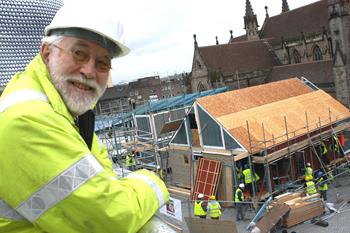Offsite to double in next 5 years
CIOB BIM+ Lack of Knowledge Two thirds of construction bosses expect to double the amount of construction work they carry out using offsite manufacturing (OSM) over the next five years, although the cost of investment and a lack of knowledge is currently holding the sector back. That’s according to a survey of 31 executives from the UK’s top 50 construction firms conducted by law firm Clyde & Co, as part of its Innovation in Construction Report. Top Insights The report contains insight from 15 executives, including Mark Farmer of Cast, Susan-Hone Brooks of the Manufacturing Technology Centre, Jamie Johnston of Bryden Wood, Matt Gough of Mace and Toby Uppington of Aecom. A total of 59% of the executives believe investment costs are the primary factor hindering the implementation of OSM, followed by a lack of expertise in their organisation (48%). OSM Use to Double in next 5 Years Currently 80% of respondents’ organisations only use OSM for 1%-20% of the construction work they carry out. Nonetheless, 61% expect their use of OSM techniques to double within the next five years, according to the survey. Investment in OSM to Triple Just over half (55%) of survey respondents invested only 0-2% of revenue on OSM in the last five years, while in five years just 6% expect to invest at this level. The majority plan to invest much more – 39% plan to invest between 3-5% and 42% between 6-20% of revenue in OSM. OSM Increases Productivity Robert Meakin, projects & construction partner at Clyde & Co, said: “OSM has been at the bottom of the UK construction industry’s tool box for decades, but it is now being heralded by many as the key to tackling chronic low productivity problems”. Tipping Point Within Reach In Meakin’s view, “Over the last couple of years momentum has been building and with the government now actively encouraging the use of OSM in some of its projects, the tipping point appears to be within reach.” Warning & Caveats But Meakin also warned that since the decline of PFI/PPP at the beginning of the decade, the industry has seen a severely limited flow of new schemes, making it a very difficult commercial decision to invest seriously in OSM technology without a clear plan of how and when it will deliver a return. Top Reasons to Invest in OSM According to the report, the top three reasons cited for investing in OSM are: To improve efficiency and reduce costs (97%); To overcome new challenges in construction (84%); To help overcome the skills shortage (61%). Skills Irony Meakin commented: “It is ironic that so many would invest in OSM to overcome the skills shortage, when one of the key barriers to implementation is a lack of relevant expertise. This will not be missed by UK construction’s boardrooms.” Chicken & Egg Meakin sees this as something of a chicken and egg situation. Those who find a solution are likely to gain a clear advantage over their competition. He comments that “We may soon find the construction industry starting to look to the manufacturing sector for new recruits.” Off-Site for Manufacture & Assembly Resistance to change has been the norm, but challenges from new entrants – e.g. Chinese and Insurance Companies – coupled with changes in other areas are now beginning to bite hard. As ‘OffSite Hub” note, architects and designers are moving toward DfMA, something w have been encouraging for over 20 years. To assist them in doing so our “Easy Timber Frame “ now offers standard size modular timber frame elements for them to use as a design base, cutting down on technical design and engineering to produce win-win results.Visit the Benfield ATT Group website for more information on Offsite to double in next 5 years






